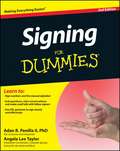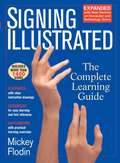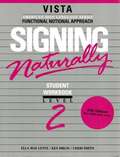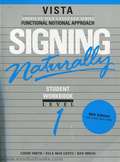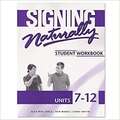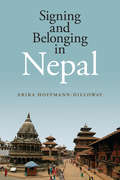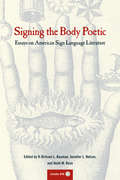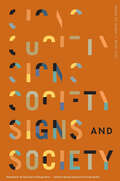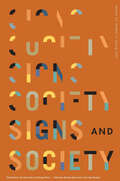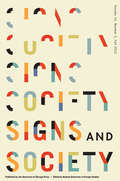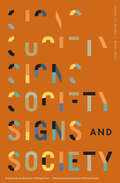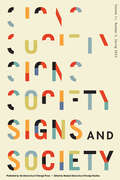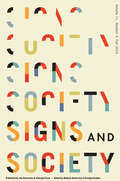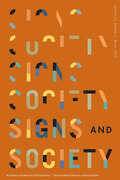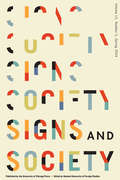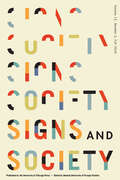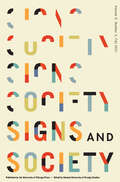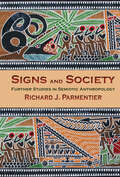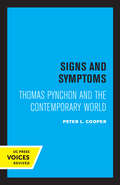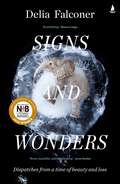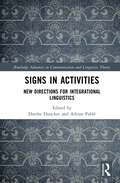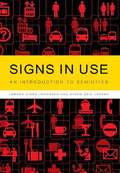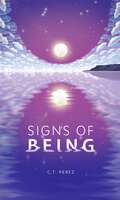- Table View
- List View
Signing For Dummies
by Angela Lee Taylor Adan R. Penilla IIThe fast and easy way to grasp this evolving and growing languageAmerican Sign Language (ASL) is something we've all seen deaf people use in restaurants, hospitals, airports, and at work. The communication is fascinating to watch; to see people sharing ideas by using handshapes and body language is remarkable in a world so defined by sound. This new edition of Signing For Dummies gives you a general understanding of the properties of Sign, as well as an understanding of deaf culture. Designed to act as an introduction or a refresher, the book focuses solely on ASL, which is the most commonly used sign language in the United States. Categorized by subject, this illustrated guide covers grammar and sentence structure, along with the tools to get you going in basic conversation by knowing how to introduce and greet people; ask questions and make small talk; order food and chat with salespeople; handle medical emergencies; talk on the phone; get around town for fun or business; and much more. Plus, it stresses how ASL isn't just about using your fingers, hands, and arms, but also about facial expression and body language.More than 25 percent new and revised content, including the latest technological advances for the deaf; contact signing, code mixing, code switching, interpreting as a profession, and regionalism in signingPacked with "Fun & Games" sections that invite you to practice specific signsHundreds of illustrations throughout, plus a video CD featuring demonstrations by ASL signers showing actual conversationsSigning For Dummies is the fast and fun way to get you moving your hands, body, and face to convey meaning that reaches beyond linguistic barriers.
Signing Illustrated
by Mickey Flodin"Whether you have a casual interest in signing, or a sincere desire to communicate with deaf people, Signing Illustrated provides all the basic vocabulary and instructions you need to learn how to sign. Even though it takes considerable time to become a proficient signer, you will soon be signing basic concepts after studying only a chapter or two. Persons who are deaf are pleased when others learn their language, and they are patient and understanding with the beginning signer." Each chapter covers a specific category of signs, making this a useful reference tool.
Signing Naturally Level 2
by Cheri Smith Ella Mae Lentz"Each of the five units in Level 2 revolves around a major language function: locating things around the house; complaining and making requests; talking about life events, nationalities and family histories; describing objects; talking about the weekend."--Introduction.
Signing Naturally: Student Workbook Level 1
by Cheri Smith Ella Mae Lentz Ken MikosAn excellent resource book, with over 1000 signs and 100 useful phrases. Activities are video-interactive, with the emphasis on language in context, featuring useful vocabulary and expressions. Readings about culture and language are included to enhance your understanding of ASL and the Deaf experience.
Signing Naturally: Student Workbook, Units 7-12
by Cheri Smith Ella Mae Lentz Ken MikosDesigned to give students a deeper insight into ASL and Deaf culture. Signing Naturally Units 7-12 Student Workbook offers homework assignments that support what you've learned in the classroom. Signing Naturally Units 7-12 Student Workbook also features Deaf culture articles and profiles of legendary Deaf leaders. There's also a topic index to help you find signs and information easily. The Signing Naturally Units 7-12 Student Workbook also includes over seven hours of ASL video material on two DVDs signed by 13 skilled native signers. Signing Naturally Units 7-12 Student Workbook is everything you need to bring your ASL skills BEYOND the classroom.
Signing and Belonging in Nepal
by Erika Hoffmann-DillowayWhile many deaf organizations around the world have adopted an ethno-linguistic framing of deafness, the meanings and consequences of this perspective vary across cultural contexts, and relatively little scholarship exists that explores this framework from an anthropological perspective. In this book, Erika Hoffmann-Dilloway presents an accessible examination of deafness in Nepal. As a linguistic anthropologist, she describes the emergence of Nepali Sign Language and deaf sociality in the social and historical context of Nepal during the last decades before the Hindu Kingdom became a secular republic. She then shows how the adoption of an ethno-linguistic model interacted with the ritual pollution model, or the prior notion that deafness results from bad karma. Her focus is on the impact of these competing and co-existing understandings of deafness on three groups: signers who adopted deafness as an ethnic identity, homesigners whose ability to adopt that identity is hindered by their difficulties in acquiring Nepali Sign Language, and hearing Nepalis who interact with Deaf signers. Comparing these contexts demonstrates that both the ethno-linguistic model and the ritual pollution model, its seeming foil, draw on the same basic premise: that both persons and larger social formations are mutually constituted through interaction. Signing and Belonging in Nepal is an ethnography that studies a rich and unique Deaf culture while also contributing to larger discussions about social reproduction and social change.
Signing the Body Poetic: Essays on American Sign Language Literature
by W. J. T. Mitchell Jennifer L. Nelson H-Dirksen L. Bauman William C. Stokoe Heidi M. RoseThis unique collection of essays at last brings a dazzling view of the literary, social, and performative aspects of American Sign Language to a wide audience. The book presents the work of a renowned and diverse group of deaf, hard-of-hearing, and hearing scholars who examine original ASL poetry, narrative, and drama. The book showcases the poems and narratives under discussion in their original form, providing access to them for hearing non-signers for the first time. The book provides new insight into the history, culture, and creative achievements of the deaf community while expanding the scope of the visual and performing arts, literary criticism, and comparative literature.
Signing the Body: Marks on Skin in Early Modern France
by Katherine Dauge-RothThe first major scholarly investigation into the rich history of the marked body in the early modern period, this interdisciplinary study examines multiple forms, uses, and meanings of corporeal inscription and impression in France and the French Atlantic from the late sixteenth through early eighteenth centuries. Placing into dialogue a broad range of textual and visual sources drawn from areas as diverse as demonology, jurisprudence, mysticism, medicine, pilgrimage, commerce, travel, and colonial conquest that have formerly been examined largely in isolation, Katherine Dauge-Roth demonstrates that emerging theories and practices of signing the body must be understood in relationship to each other and to the development of other material marking practices that rose to prominence in the early modern period. While each chapter brings to light the particular histories and meanings of a distinct set of cutaneous marks—devil’s marks on witches, demon’s marks upon the possessed, devotional wounds, Amerindian and Holy Land pilgrim tattoos, and criminal brands—each also reveals connections between these various types of stigmata, links that were obvious to the early modern thinkers who theorized and deployed them. Moreover, the five chapters bring to the fore ways in which corporeal marking of all kinds interacted dynamically with practices of writing on, imprinting, and engraving paper, parchment, fabric, and metal that flourished in the period, together signaling important changes taking place in early modern society. Examining the marked body as a material object rife with varied meanings and uses, Signing the Body: Marks on Skin in Early Modern France shows how the skin itself became the register of the profound cultural and social transformations that characterized this era.
Signing: A Basic Guide
by Karen L. Saulnier Harry Bornstein Ralph R. MillerNow available as an eBook, this quick-reference dictionary is for everyone who knows, cares about, or wants to communicate with someone who is deaf or hearing impaired. Designed by Harry Bornstein and Karen L. Saulnier, two of the foremost experts on sign language, Signing features more than one thousand black-and-white illustrations created specifically for hearing and non-hearing people who want to learn how to sign. Packed with grammar tips and vocabulary words arranged by subject for easy reference, Signing is a comprehensive guide to mastering the basics of Signed English and can be used alone or in conjunction with the Living Language video, Say it By Signing.
Signs and Society, volume 10 number 1 (Winter 2022)
by Signs and SocietyThis is volume 10 issue 1 of Signs and Society. Signs and Society is an open-access, multidisciplinary journal in the humanities and social sciences focusing on research that examines the role of sign processes (or semiosis) in social interaction, cognition, and cultural formations. Focusing directly on semiosis in its multiple dimensions, the journal aims to promote collaborative translation across analytical categories and technical vocabularies already established in anthropology, linguistics, semiotics, and related disciplines, and to uncover unanticipated parallels in the ways semiosis is manifest in diverse empirical domains.
Signs and Society, volume 10 number 2 (Spring 2022)
by Signs and SocietyThis is volume 10 issue 2 of Signs and Society. Signs and Society is an open-access, multidisciplinary journal in the humanities and social sciences focusing on research that examines the role of sign processes (or semiosis) in social interaction, cognition, and cultural formations. Focusing directly on semiosis in its multiple dimensions, the journal aims to promote collaborative translation across analytical categories and technical vocabularies already established in anthropology, linguistics, semiotics, and related disciplines, and to uncover unanticipated parallels in the ways semiosis is manifest in diverse empirical domains.
Signs and Society, volume 10 number 3 (Fall 2022)
by Signs and SocietyThis is volume 10 issue 3 of Signs and Society. Signs and Society is an open-access, multidisciplinary journal in the humanities and social sciences focusing on research that examines the role of sign processes (or semiosis) in social interaction, cognition, and cultural formations. Focusing directly on semiosis in its multiple dimensions, the journal aims to promote collaborative translation across analytical categories and technical vocabularies already established in anthropology, linguistics, semiotics, and related disciplines, and to uncover unanticipated parallels in the ways semiosis is manifest in diverse empirical domains.
Signs and Society, volume 11 number 1 (Winter 2023)
by Signs and SocietyThis is volume 11 issue 1 of Signs and Society. Signs and Society is an open-access, multidisciplinary journal in the humanities and social sciences focusing on research that examines the role of sign processes (or semiosis) in social interaction, cognition, and cultural formations. Focusing directly on semiosis in its multiple dimensions, the journal aims to promote collaborative translation across analytical categories and technical vocabularies already established in anthropology, linguistics, semiotics, and related disciplines, and to uncover unanticipated parallels in the ways semiosis is manifest in diverse empirical domains.
Signs and Society, volume 11 number 2 (Spring 2023)
by Signs and SocietyThis is volume 11 issue 2 of Signs and Society. Signs and Society is an open-access, multidisciplinary journal in the humanities and social sciences focusing on research that examines the role of sign processes (or semiosis) in social interaction, cognition, and cultural formations. Focusing directly on semiosis in its multiple dimensions, the journal aims to promote collaborative translation across analytical categories and technical vocabularies already established in anthropology, linguistics, semiotics, and related disciplines, and to uncover unanticipated parallels in the ways semiosis is manifest in diverse empirical domains.
Signs and Society, volume 11 number 3 (Fall 2023)
by Signs and SocietyThis is volume 11 issue 3 of Signs and Society. Signs and Society is an open-access, multidisciplinary journal in the humanities and social sciences focusing on research that examines the role of sign processes (or semiosis) in social interaction, cognition, and cultural formations. Focusing directly on semiosis in its multiple dimensions, the journal aims to promote collaborative translation across analytical categories and technical vocabularies already established in anthropology, linguistics, semiotics, and related disciplines, and to uncover unanticipated parallels in the ways semiosis is manifest in diverse empirical domains.
Signs and Society, volume 12 number 1 (Winter 2024)
by Signs and SocietyThis is volume 12 issue 1 of Signs and Society. Signs and Society is an open-access, multidisciplinary journal in the humanities and social sciences focusing on research that examines the role of sign processes (or semiosis) in social interaction, cognition, and cultural formations. Focusing directly on semiosis in its multiple dimensions, the journal aims to promote collaborative translation across analytical categories and technical vocabularies already established in anthropology, linguistics, semiotics, and related disciplines, and to uncover unanticipated parallels in the ways semiosis is manifest in diverse empirical domains.
Signs and Society, volume 12 number 2 (Spring 2024)
by Signs and SocietyThis is volume 12 issue 2 of Signs and Society. Signs and Society is an open-access, multidisciplinary journal in the humanities and social sciences focusing on research that examines the role of sign processes (or semiosis) in social interaction, cognition, and cultural formations. Focusing directly on semiosis in its multiple dimensions, the journal aims to promote collaborative translation across analytical categories and technical vocabularies already established in anthropology, linguistics, semiotics, and related disciplines, and to uncover unanticipated parallels in the ways semiosis is manifest in diverse empirical domains.
Signs and Society, volume 12 number 3 (Fall 2024)
by Signs and SocietyThis is volume 12 issue 3 of Signs and Society. Signs and Society is an open-access, multidisciplinary journal in the humanities and social sciences focusing on research that examines the role of sign processes (or semiosis) in social interaction, cognition, and cultural formations. Focusing directly on semiosis in its multiple dimensions, the journal aims to promote collaborative translation across analytical categories and technical vocabularies already established in anthropology, linguistics, semiotics, and related disciplines, and to uncover unanticipated parallels in the ways semiosis is manifest in diverse empirical domains.
Signs and Society, volume 9 number 3 (Fall 2021)
by Signs and SocietyThis is volume 9 issue 3 of Signs and Society. Signs and Society is an open-access, multidisciplinary journal in the humanities and social sciences focusing on research that examines the role of sign processes (or semiosis) in social interaction, cognition, and cultural formations. Focusing directly on semiosis in its multiple dimensions, the journal aims to promote collaborative translation across analytical categories and technical vocabularies already established in anthropology, linguistics, semiotics, and related disciplines, and to uncover unanticipated parallels in the ways semiosis is manifest in diverse empirical domains.
Signs and Society: Further Studies in Semiotic Anthropology
by Richard J. ParmentierA major voice in contemporary semiotic theory offers a new perspective on potent intersections of semiotic and linguistic anthropology.In Signs and Society, noted anthropologist Richard J. Parmentier demonstrates how an appreciation of signs helps us better understand human agency, meaning, and creativity. Inspired by the foundational work of C. S. Peirce and Ferdinand de Saussure, and drawing upon key insights from neighboring scholarly fields, Parmentier develops an array of innovative conceptual tools for ethnographic, historical, and literary research.Parmentier’s concepts of “transactional value,” “metapragmatic interpretant,” and “circle of semiosis,” for example, illuminate the foundations and effects of such diverse cultural forms and practices as economic exchanges on the Pacific island of Palau, Pindar’s Victory Odes in ancient Greece, and material representations of transcendence in ancient Egypt and medieval Christianity.Other studies complicate the separation of emic and etic analytical models for such cultural domains as religion, economic value, and semiotic ideology. Provocative and absorbing, these fifteen pioneering essays blaze a trail into anthropology’s future while remaining firmly rooted in its celebrated past.
Signs and Symptoms: Thomas Pynchon and the Contemporary World
by Peter L. CooperThis title is part of UC Press's Voices Revived program, which commemorates University of California Press’s mission to seek out and cultivate the brightest minds and give them voice, reach, and impact. Drawing on a backlist dating to 1893, Voices Revived makes high-quality, peer-reviewed scholarship accessible once again using print-on-demand technology. This title was originally published in 1983.
Signs and Wonders: Dispatches from a time of beauty and loss
by Delia FalconerThe celebrated, Walkley Award-winning author on how global warming is changing not only our climate but our culture. Beautifully observed, brilliantly argued and deeply felt, these essays show that our emotions, our art, our relationships with the generations around us – all the delicate networks that make us who we are – have already been transformed. In Signs and Wonders, Falconer explores how it feels to live as a reader, a writer, a lover of nature and a mother of small children in an era of profound ecological change. Building on Falconer&’s two acclaimed essays, &‘Signs and Wonders&’ and the Walkley Award-winning &‘The Opposite of Glamour&’, Signs and Wonders is a pioneering examination of how we are changing our culture, language and imaginations along with our climate. Is a mammoth emerging from the permafrost beautiful or terrifying? How is our imagination affected when something that used to be ordinary – like a car windscreen smeared with insects – becomes unimaginable? What can the disappearance of the paragraph from much contemporary writing tell us about what&’s happening in the modern mind? Scientists write about a 'great acceleration' in human impact on the natural world. Signs and Wonders shows that we are also in a period of profound cultural acceleration, which is just as dynamic, strange, extreme and, sometimes, beautiful. Ranging from an &‘unnatural&’ history of coal to the effect of a large fur seal turning up in the park below her apartment, this book is a searching and poetic examination of the ways we are thinking about how, and why, to live now. &‘Only the finest of writers can hope to convey the mercurial nature of the times we are living though: the sense of slippage; of terror and beauty. Falconer is such a writer. Signs and Wonders is an essential collection.&’ Sophie Cunningham, author of City of Trees &‘Delia Falconer is one of the best writers working today, and in Signs and Wonders she demonstrates everything that makes her writing so necessary. Brave, beautiful, and breathtaking in its elegance and intelligence, it is, quite simply, a marvel.&’ James Bradley &‘Scintillating. Delia Falconer is at the peak of her powers as a critic, and as an observer of the natural world. Signs and Wonders looks outward from Sydney, and from literature, to trace the contours of our environmental moment.&’ Rebecca Giggs, author of Fathoms
Signs in Activities: New Directions for Integrational Linguistics (Routledge Advances in Communication and Linguistic Theory)
by Dorthe Duncker Adrian PabléThis book is a collective volume bringing together scholars who share an interest in linguistics from an integrational point of view and in developing new directions for future scholarship.Integrational linguistics invites us to rethink the theoretical and methodological premises of general linguistics by drawing on a different conception of the sign and by recognizing the creativity that human communication requires. Some chapters are concerned with concepts like the sign, contextualization, activity, and integration. Although being core concepts developed by the founder of integrational linguistics, Roy Harris, they have arguably remained underdeveloped in Harris’ writings and thus call for further clarification and investigation. Other chapters are concerned with the notions of the self and the social, experience and interaction, with questions about individual agency and will, and human sociality and social organization, which all occupy a central position in integrational theory. Finally, remaining chapters focus on how scriptism and the language myth have influenced our way of thinking about communication in a broad sense.This edited collection will be of interest to a multidisciplinary readership comprising those engaged in study, teaching, and research in the humanities and social sciences, including anthropology, the arts, education, linguistics, literary studies, philosophy, psychology, and semiotics.
Signs in Use: An Introduction to Semiotics
by Jørgen Dines Johansen Svend Erik LarsenSigns in Use is an accessible introduction to the study of semiotics.All organisms, from bees to computer networks, create signs, communicate, and exchange information. The field of semiotics explores the ways in which we use these signs to make inferences about the nature of the world.Signs in Use cuts across different semiotic schools to introduce six basic concepts which present semiotics as a theory and a set of analytical tools: code, sign, discourse, action, text, and culture. Moving from the most simple to the most complex concept, the book gradually widens the semiotic perspective to show how and why semiotics works as it does.Each chapter covers a problem encountered in semiotics and explores the key concepts and relevant notions found in the various theories of semiotics. Chapters build gradually on knowledge gained, and can also be used as self-contained units for study when supported by the extensive glossary. The book is illustrated with numerous examples, from traffic systems to urban parks, and offers useful biographies of key twentieth-century semioticians.
Signs of Being
by C.T. PerezSigns of Being is a collection of poetry, prose, and commentary born from the insights, observations, and experiences of C.T. Perez to understand the realms of CHamoru cultural identity. This work aims to articulate the mindscape of an indigenous CHamoru consciousness through ec(h)o literature: literature that interprets signs in the natural environment as echoes from ancestors. Guided by her saina, or elders, Perez invites readers to join her on a journey through the complexities and intricacies of identity, heritage, memory, and place.
